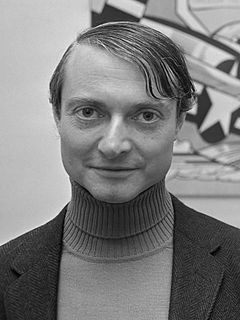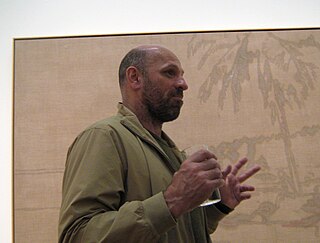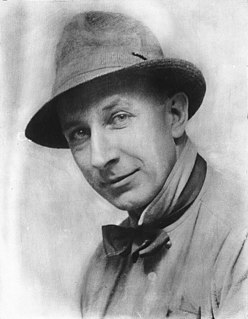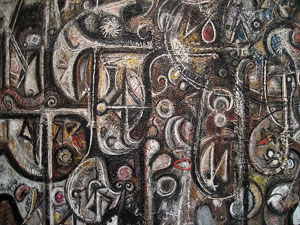Related Research Articles

Roy Fox Lichtenstein was an American pop artist. During the 1960s, along with Andy Warhol, Jasper Johns, and James Rosenquist among others, he became a leading figure in the new art movement. His work defined the premise of pop art through parody. Inspired by the comic strip, Lichtenstein produced precise compositions that documented while they parodied, often in a tongue-in-cheek manner. His work was influenced by popular advertising and the comic book style. He described pop art as "not 'American' painting but actually industrial painting". His paintings were exhibited at the Leo Castelli Gallery in New York City.

Bridget Louise Riley is an English painter known for her singular op art paintings. She lives and works in London, Cornwall and the Vaucluse in France.

Visual art of the United States or American art is visual art made in the United States or by U.S. artists. Before colonization there were many flourishing traditions of Native American art, and where the Spanish colonized Spanish Colonial architecture and the accompanying styles in other media were quickly in place. Early colonial art on the East Coast initially relied on artists from Europe, with John White the earliest example. In the late 18th and early 19th centuries, artists primarily painted portraits, and some landscapes in a style based mainly on English painting. Furniture-makers imitating English styles and similar craftsmen were also established in the major cities, but in the English colonies, locally made pottery remained resolutely utilitarian until the 19th century, with fancy products imported.

Lucian Michael Freud, OM CH was a British painter and draughtsman, specialising in figurative art, and is known as one of the foremost 20th-century portraitists. He was born in Berlin, the son of Jewish architect Ernst L. Freud and the grandson of Sigmund Freud. Freud got his first name "Lucian" from his mother in memory of the ancient writer Lucian of Samosata. His family moved to England in 1933 to escape the rise of Nazism. From 1942–43 he attended Goldsmiths College, London. He served at sea with the British Merchant Navy during the Second World War.

Peter Doig is a Scottish painter. One of the most renowned living figurative painters, he has settled in Trinidad since 2002. In 2007, his painting White Canoe sold at Sotheby's for $11.3 million, then an auction record for a living European artist. In February 2013, his painting, The Architect's Home in the Ravine, sold for $12 million at a London auction. Art critic Jonathan Jones said about him: "Amid all the nonsense, impostors, rhetorical bullshit and sheer trash that pass for art in the 21st century, Doig is a jewel of genuine imagination, sincere work and humble creativity."

John Lurie is an American musician, painter, actor, director, and producer. He co-founded The Lounge Lizards jazz ensemble, acted in 19 films, including Stranger than Paradise and Down by Law, composed and performed music for 20 television and film works, and produced, directed, and starred in the Fishing with John television series. In 1996 his soundtrack for Get Shorty was nominated for a Grammy Award, and his album The Legendary Marvin Pontiac: Greatest Hits has been praised by both critics and fellow musicians.

Richard William Hamilton CH was an English painter and collage artist. His 1955 exhibition Man, Machine and Motion and his 1956 collage Just what is it that makes today's homes so different, so appealing?, produced for the This Is Tomorrow exhibition of the Independent Group in London, are considered by critics and historians to be among the earliest works of pop art. A major retrospective of his work was at Tate Modern until May 2014.

George Wesley Bellows was an American realist painter, known for his bold depictions of urban life in New York City. He became, according to the Columbus Museum of Art, "the most acclaimed American artist of his generation".

John Keith Vaughan, generally known as Keith Vaughan, was a British painter.
Alex Katz, is an American figurative artist known for his paintings, sculptures, and prints.

Lucio Fontana was an Argentine-Italian painter, sculptor and theorist. He is mostly known as the founder of Spatialism.

Richard Warren Pousette-Dart was an American abstract expressionist artist most recognized as a founder of the New York School of painting. His artistic output also includes drawing, sculpture, and fine-art photography.
Elizabeth Joy Peyton is an American contemporary artist working primarily in painting, drawing, and printmaking. Best known for figures from her own life and those beyond it, including close friends, historical personae, and icons of contemporary culture, Peyton’s portraits have regularly featured artists, writers, musicians, and actors.
Huma Bhabha is a Pakistani-American sculptor based in Poughkeepsie, New York. Known for her uniquely grotesque, figurative forms that often appear dissected or dismembered, Bhabha often uses found materials in her sculptures, including styrofoam, cork, rubber, paper, wire, and clay. She occasionally incorporates objects given to her by other people into her artwork. Many of these sculptures are also cast in bronze. She is equally prolific in her works on paper, creating vivid pastel drawings, eerie photographic collages, and haunting print editions.
Will Barnet was an American artist known for his paintings, watercolors, drawings, and prints depicting the human figure and animals, both in casual scenes of daily life and in transcendent dreamlike worlds.

Philip Howard Francis Dixon Evergood was an American painter, etcher, lithographer, sculptor, illustrator and writer. He was particularly active during the Depression and World War II era.

Thornton Dial was a pioneering African-American artist who came to prominence in the late 1980s. Dial's body of work exhibits formal variety through expressive, densely composed assemblages of found materials, often executed on a monumental scale. His range of subjects embraces a broad sweep of history, from human rights to natural disasters and current events. Dial's works are widely held in American museums; ten of Dial's works were acquired by the Metropolitan Museum of Art in 2014.

Mary Rubin Schepisi is an American artist currently working in Melbourne, Australia, and New York City. She is married to the film director Fred Schepisi.

Peter Plagens is an American artist, art critic, and novelist based in New York City. He is most widely known for his longstanding contributions to Artforum and Newsweek, and for what critics have called a remarkably consistent, five-decade-long body of abstract formalist painting. Plagens has written three books on art, Bruce Nauman: The True Artist (2014), Moonlight Blues: An Artist's Art Criticism (1986) and Sunshine Muse: Modern Art on the West Coast, 1945-70 (1974), and two novels, The Art Critic (2008) and Time for Robo (1999). He has been awarded major fellowships for both his painting and his writing. Plagens's work has been featured in surveys at the Museum of Modern Art, Los Angeles County Museum of Art (LACMA), Whitney Museum, and PS1, and in solo exhibitions at the Hirshhorn Museum and Las Vegas Art Museum. In 2004, the USC Fisher Gallery organized and held a 30-year traveling retrospective of his work. Critics have contrasted the purely visual dialogue his art creates—often generating more questions than answers—with the directness of his writing; they also contend that the visibility of his bylines as a critic has sometimes overshadowed his artmaking—unduly. Los Angeles Times critic David Pagel described Plagens's painting as a "fusion of high-flying refinement and everyday awkwardness" with an intellectual savvy, disdain for snobbery and ungainliness he likened to Willem de Kooning's work. Reviewing Plagens's 2018 exhibition, New York Times critic Roberta Smith called the show an "eye-teasing sandwich of contrasting formalist strategies," the hard-won result of a decade of focused experimentation.

Desmond W. Helmore is a New Zealand artist and illustrator, known both for his fine art and for his scientific work depicting insects, not least illustrating the New Zealand Arthropod Collection. One of the country's most noted and prolific biological illustrators, over 1000 of his illustrations of insects were published in research papers from 1976 to 2006.
References
- 1 2 3 "Richard Wathen". artnet. Retrieved 2011-01-10.
- 1 2 Goodrich, John (2007-07-12). "Traditions & Their Uses". New York Sun. Retrieved 2011-01-10.
- 1 2 Smith, Roberta (2005-05-06). "Making an Entrance at Any Age". New York Times. p. 2. Retrieved 2011-01-10.
- ↑ "Max Wigram Gallery: Richard Wathen". ArtSlant. Retrieved 2011-01-10.
- 1 2 Brown, Neal. "Touching Greatness". The First Post. Retrieved 2011-01-10.
- 1 2 "Richard Wathen". L&M Arts. Retrieved 2011-01-10.
- ↑ "Richard Wathen". Art Facts. Retrieved 2011-01-10.
- ↑ "Mothers" . Retrieved 2011-01-10.